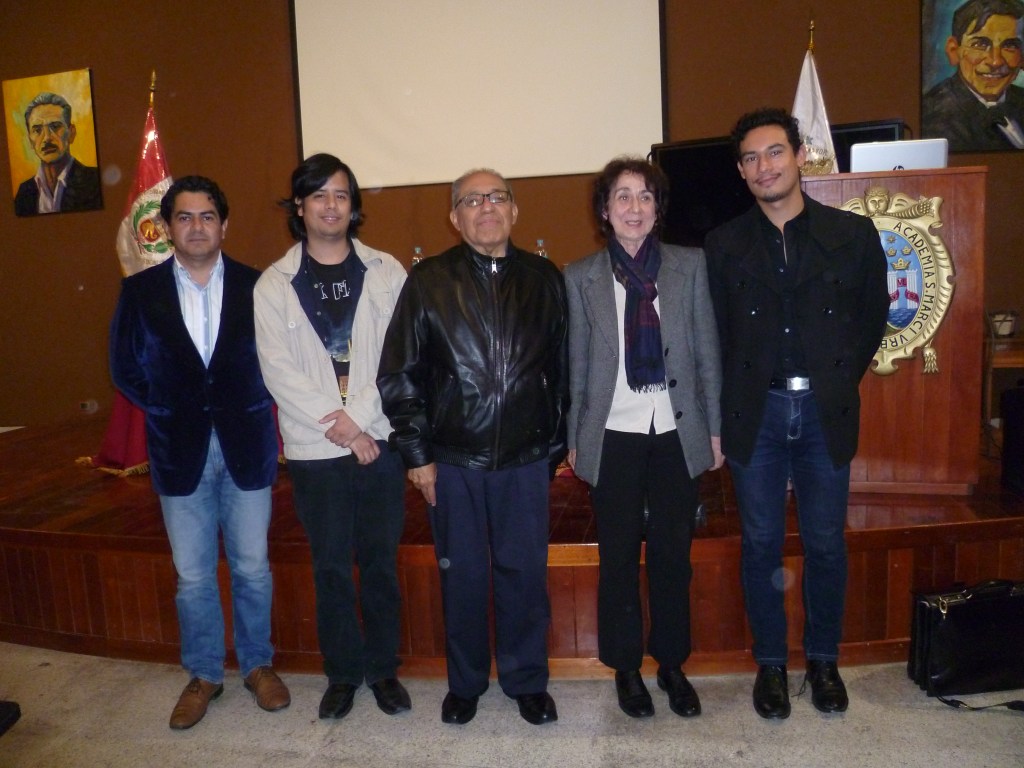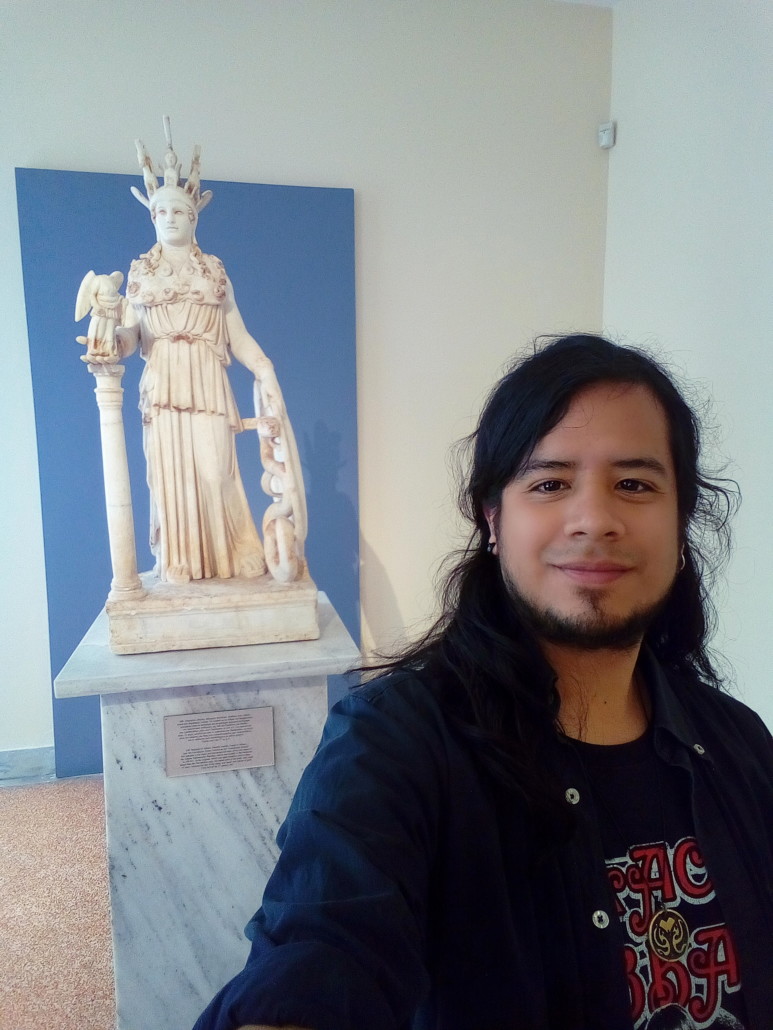The conference, “Religion in Peru : Research itineraries from the social sciences,” was held at the Universidad Nacional Mayor de San Marcos, Lima-Peru, 24 September 2015. Conference report for The Religious Studies Project by Sidney Castillo.
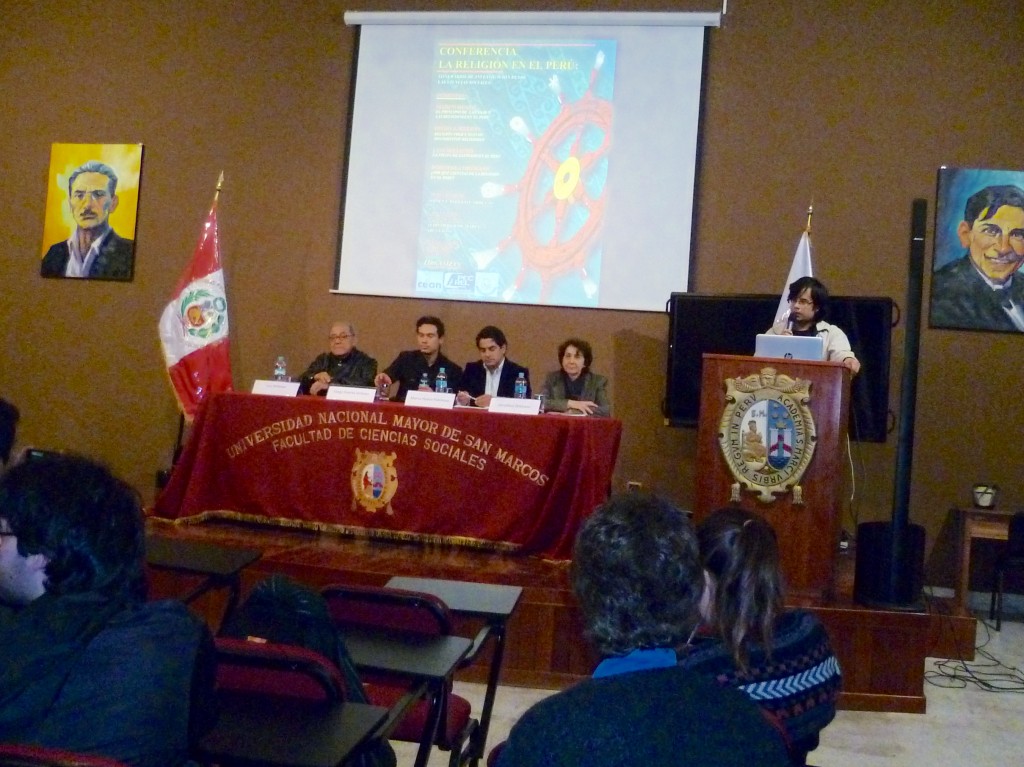
The study of religion has deep roots in the South American country of Peru. Over twenty years ago, one of this country’s most eminent scholars of religion, the late Manuel Marzal, (1996) wrote an article detailing a century of religious studies in Peru. Since the dawn of social sciences in Peruvian academia, scholars from different schools of thought and institutions have applied their own perspectives to religion, from indigenism to Marxism—and of course the catholic church. These scholars wanted to get a grip on what means to be religious in Peru in order to better understand its people, however they also differed in key ways. For example, some have been concerned with religion as it may relate to establishing enduring political structures, to gain more adherents, or for good old fashioned criticism. Peru is a country rich with not only religious tradition, but also religious innovation. For example, we have both our equivalent of the Popol Vuh, the Dioses y hombres de Huarochirí [1] manuscript from the sixteenth century, and also a Peruvian new religious movement, the Asociación Evangélica de la Misión Israelita del Nuevo Pacto Universal from the twentieth century as examples; this is why the conference presented different approaches to the study of religious phenomena, and discussed its relevance in the 21st century.
The conference was organized by the Master’s Degree in Sciences of Religion of the Faculty of Social Sciences from Universidad Nacional Mayor de San Marcos, represented by its Coordinator, Jaime Regan and myself (Sidney Castillo) as organizer, in collaboration with the Students Center of Anthropology of the same university (CEAN in Spanish) and the Peruvian Academy of the Sciences of Religion (APECREL also in Spanish). The conference featured anthropological researches based on case study and comparative religion approaches, as well as sociological research in the field of secularism and state regulations, and the sciences of religion itself as an academic field. The scholars who participated in the event were Luis Millones (Professor Emeritus of Universidad Nacional Mayor de San Marcos), Diego Huerta (University of Helsinki), Marco Huaco (University of Strasbourg) and Dorothea Ortmann (University of Rostock).
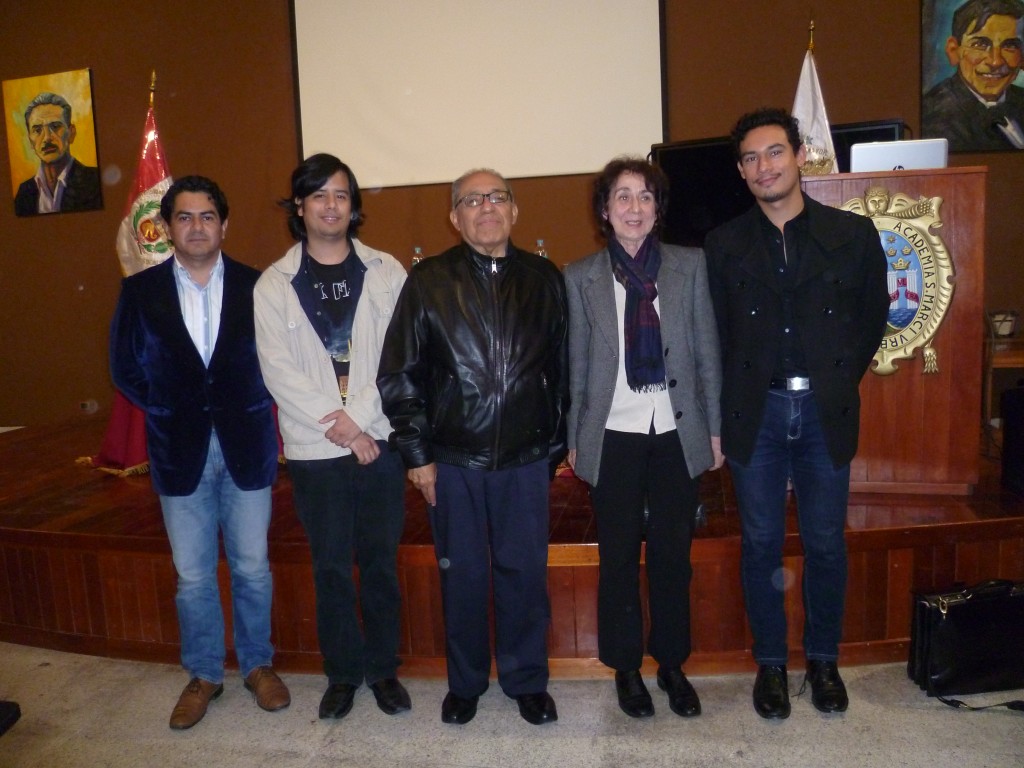
For myself, as an organizer, it was particularly fulfilling to see the conference auditorium packed and the scholars ready to take the lead on the subject that was of our interest. And it was also fulfilling because we had a lot of competition that day: three academic events in the same faculty at pretty much the same time! We can say then, that people is really getting interested in learning about religion outside mainstream means e.g. churches.
Luis Millones’s talk was about Apostle Santiago and the Moors (Millones : 2015). He presented his latest research done in San Lucas de Colan, a small town within the Paita province in the coastal part of Piura region. His ethnographic research provided an insiders appreciation of the festival offered to Santiago Apostle’s horse, Felipe, in which the image of the patron saint observes the symbolic representation of the horse battling against the Moors. The festival commands both a huge participation on money and coordination from the brotherhood of the saint. Millones viewed this as a means of obtaining prestige among the townsfolk. Interestingly, these kind of festivities are a staple in many different rural and urban places. Particularly, as it’s a way of recreating social bonds with fellow members of the community (or former communities since a lot of people that participate in these celebrations are migrants) by venerating the patron saint and having a huge party lasting several days.
In the second talk, Diego Huerta used a comparative approach in discussing two religious phenomenons comprising some of his past research: the pilgrimage of the Christ of Huamantanga in the outer part of Lima, in the Canta district ; and the (neo)paganism in the urban parts of Lima (Huerta : 2012). His aim was to put into question the factual realization of the secularization process in Peru, in order to examine folk religion and new religious movements as manifestations of an alternative religiosity. Huerta suggested that while the former is more related to popular interpretations of Catholicism, the latter stems more from a product of globalization, embedded in a culture of media driven information on different religious traditions. I found his presentation as indicating that not even tradition is written in stone, tradition changes.
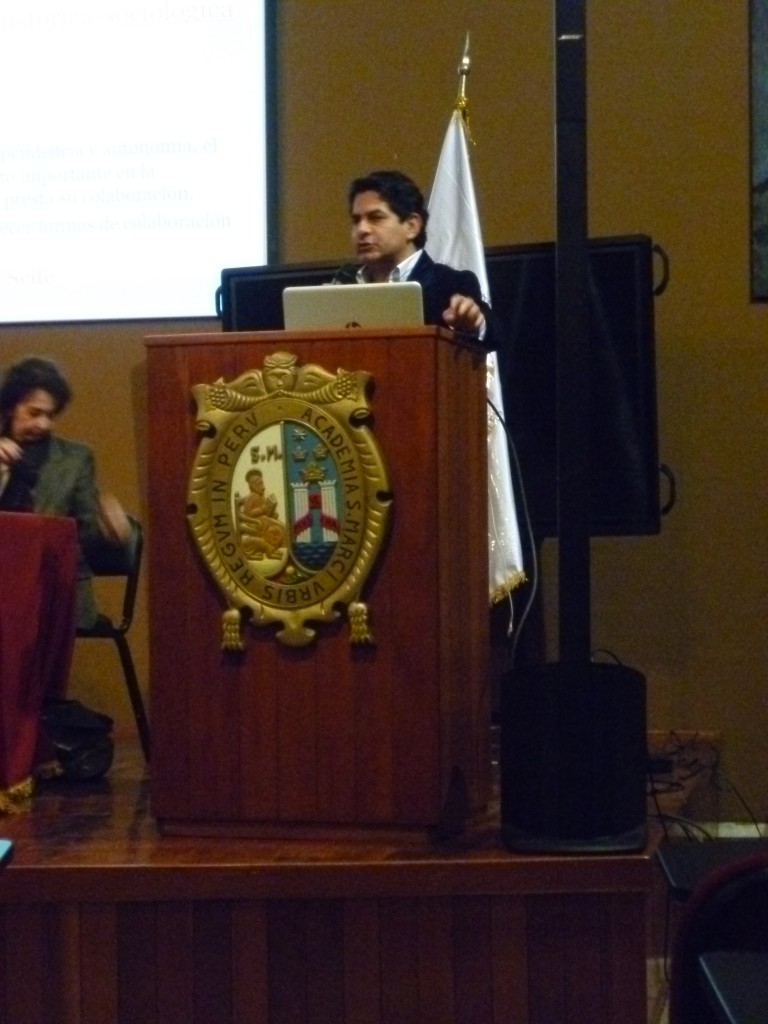
In the third presentation, Marco Huaco’s discussed the policy of laicidad, a.k.a. secularism in church-state relations (Huaco : 2013). He detailed the historical trajectory of the Peruvian constitutions, demonstrating their evolution, developing from constitutions of doctrinal confessionality towards constitutions of historical-sociological confessionality, finally arriving to the present day constitution. This constitution acknowledges the Catholic Church an important element of Peruvian society, and allows the State to take part in partnership with other religious denominations. This is highlighted by the 1980 Agreement between the Holy See and Peru, which he explained, has important consequences in the ordering of public policies (e.g., birth control and lgbt rights) and primary education.
The closing presentation was delivered by Dorothea Ortmann. In it, she presented how the Sciences of Religion was first established in Peru (Ortmann: 2002). Ortmann traced the beginnings of this development from the researches of Julio C. Tello, Rafael Larco Hoyle and Luis Válcarcel, where they tried to explain the syncretism process, noting the economic and political implications of these mixtures on many Andean deities. For example, the Lanzon of Chavin de Huantar and the Teja Amaru[2]. Ortmann discussed how researchers utilized the tools from different disciplines to explain this process (e.g. archaeology, linguistics and anthropology), in order to gain a wider overview of the Andean societies.
The variety of research that was presented at the conference allowed Peru’s academic community to gather a comprehensive entry into what the academic study of religion was and is, noting future possibilities for research. In echoing Ortmann’s sentiments, the academic study of religion in Peru has existed, at least to date, due to the personal interests and dedication of lone researchers (largely at their own costs) and not due to established monetary support from institutions. However, while some valuable research has been supported at religiously affiliated institutions (e.g., Centro de Estudios Teológicos de la Amazonía, Instituto de Pastoral Andina with the Allpanchis journal, Instituto Bartolomé de las Casas, Centro de Estudios y Publicaciones) other perspectives are needed, and at further distance from pastoral inspiration. Shedding some level of ties with the insider perspectives often provided via religious institutions will allow Peruvian academics to study religious phenomena from a variety of fresh perspectives[3].
 That this conference took place at the National University of San Marcos was quite inspiring. This was the first university on the continent with a theology and arts faculty during the second half of the sixteenth century. Now, almost five hundred years later, Peruvian academics still have an interest in studying religion. However, our current perspectives and methodologies are far more diverse, and ever broadening. I remain optimistic that, in the near future, the academic study of religion in Peru will be as widespread and supported as other research areas. No doubt, this will be due in large part to the dedication and interest of Peruvian scholars, as this conference exemplifies.
That this conference took place at the National University of San Marcos was quite inspiring. This was the first university on the continent with a theology and arts faculty during the second half of the sixteenth century. Now, almost five hundred years later, Peruvian academics still have an interest in studying religion. However, our current perspectives and methodologies are far more diverse, and ever broadening. I remain optimistic that, in the near future, the academic study of religion in Peru will be as widespread and supported as other research areas. No doubt, this will be due in large part to the dedication and interest of Peruvian scholars, as this conference exemplifies.
References
Marzal, Manuel. (1996). “Un siglo de investigación de la religión en el Perú”. Anthropologica. Lima, volumen 14, número 14, pp. 7-28. Accesed on: november 29, 2015. http://revistas.pucp.edu.pe/index.php/anthropologica/article/view/1876/1809
Millones, L. (2015). “Las muchas caras de Santiago, por Luis Millones”. El Comercio. Lima, 01 of August. Accesed on: 04 de agosto de 2015. http://elcomercio.pe/opinion/columnistas/muchas-caras-santiago-luis-millones-noticia-1829935
Huaco, M. (2013). Procesos constituyentes y discursos contra-hegemónicos sobre laicidad, sexualidad y religión: Ecuador, Perú y Bolivia. Buenos Aires: CLACSO. Accesed on: november 28, 2015.
http://biblioteca.clacso.edu.ar/clacso/sur-sur/20121108040727/ProcesosConstituyentes.pdf
Ortmann, D. (2002). Ciencias de la religión en el Perú. Lima: Universidad Nacional Mayor de San Marcos. Accesed on: november 29, 2015. http://sisbib.unmsm.edu.pe/bibvirtual/libros/sociologia/c_religion/indice.htm
Huerta, D. (2012). De eclécticos e iniciados o una aproximación etnográfica a la práctica del (neo) paganismo en Lima. Licenciate thesis on Social Sciences with mention in Anthropology. Lima: Pontificia Universidad Católica del Perú, Faculty of Social Sciences.
[1] Gathered by Francisco de Avila around 1598, and then translated from quechua to spanish by Jose Maria Arguedas in the middle of the tweinthieth century, it’s the only text that accounts for the mainstream fundational mythos of Peru, prior to the spaniards arrival.
[2] The first deity refers to a monolith of 4.5 meters located in the Temple of Chavin. It depicted a zooantropomorphic god with feline and avian features (animals found in the jungle and andes respectively), and was the main deity of the Chavin culture (1000 B.C.). The second one refers to a clay shaped tile representing the Amaru god with features of a otorongo (the peruvian feline), symbolizing the resistance of the spanish influence on andean culture. Some of these tiles were found in southern andean part of Peru and date from the early XIX century.
[3] Many scholars of religion like the late Fernando Fuenzalida, Harold Hernández, Jaime Regan, Juan Ossio and our own speakers of the conference have been doing innovative work in this manner, since they have provided great insights regarding new religious movements, andean and amazonian religion, and the relationship of religion and politics.

